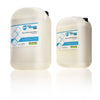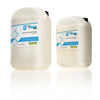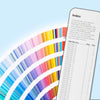Roller Maintenance Program
What causes roller problems?
Rubber rollers are manufactured with ‘hills’ and ‘valleys’ ground into their surface, so that the ink transfers easily down the roller train to the plate surface. To check their condition, use your senses of sight and touch. Rollers should have a dull, velvety appearance, and they should feel velvety smooth as you drag your finger across the roller’s surface.
If the rollers look shinny and have a glassy smooth feel to them, they are glazed. When rollers are glazed, their surface cannot transfer ink effectively. This means that you will need to run more ink and water on the press to achieve the required ink densities. Higher levels of ink and water can result in dot gain, mottled solids, hickies, ink drying problems, etc.
What are the sources of glaze?
There are actually four types of glaze that can appear on your rollers:
Aqueous glaze: paper dust and lint, residual gum and dried fountain solution. This type of glaze is removed by D-Glaze during the cleaning process.
Glaze from overprint ink varnish: residual resin, waxes and pigment from ink and varnish; this is removed by solvents in regular roller and blanket washes.
Solvent-derived glaze: residual fountain solution and ink solvents as well as solvents from poor quality washes; this type of glaze is also removed by regular roller and blanket washes.
Salt-related glaze: calcium carbonate fillers from alkaline paper, calcium from tap water and certain pigments (especially red pigments) and calcium citrate that can form from use of citric acid-based fount. Hardness minerals form tap water can also contribute. Our decalcifying product Salt Crystal Remover can remove the calcium based glaze and Eezy Klene will remove all solvent based glazes.
How do I remove these glaze components?
Step-by-Step Three Part Roller Maintenance Procedure
-
Wash up rollers if they are still inked up.
- Back off wash-up blade and apply R&B Revitaliser and run at idle speed for 3-5 minutes.
- Engage wash-up blade and rinse the rollers with your regular R&B wash.
- Rinse rollers with warm water.
- Apply Salt Crystal remover and run at idle speed for 3-5 minutes. Engage wash-up blade and wash off with warm water.
- Then, rinse with R&B wash
- Apply Eezy Klene to the rollers and run at idle speed for 3-5 minutes. Engage wash-up blade rinse rollers with R&B wash and then rinse with warm water.
- Check rollers stripes, especially the ink forms to the inside vibrator
- Check to confirm that your rollers have the correct hardness measurement, replace any rollers that are too hard or in poor physical shape.
Need to replenish your process ink or litho print supplies?
We supply a full range of Print Consumables, including Litho Process Inks, Standard Pantone Ink, Pantone Matching Guides, Litho Print Chemistry, Litho Printing Blankets and OverPrint Varnishes.
- Clive Harper






